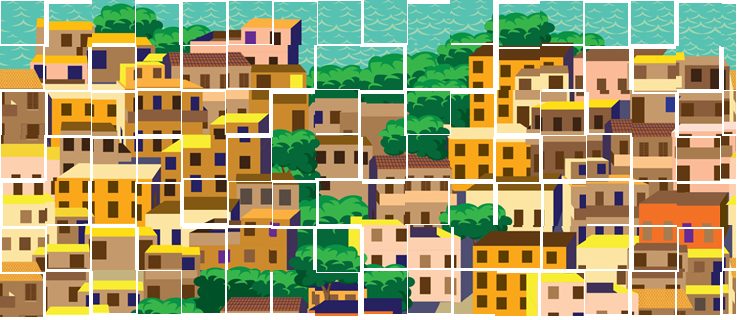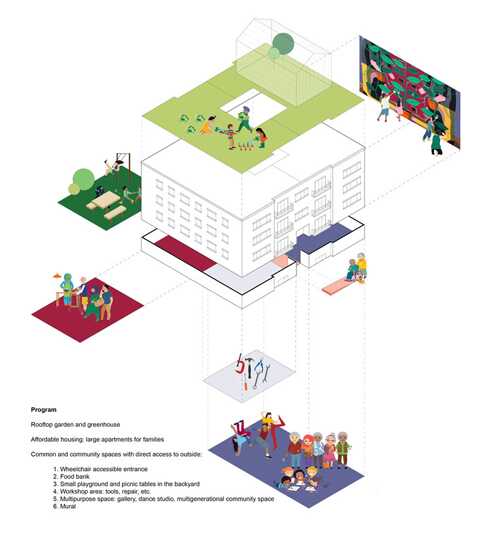Local housing project Brick by Brick
Investing in the community

Displacement due to rising housing prices has long been a major problem in Canada. The Montreal project Brique par Brique (stone by stone) tries to counteract this in the Montreal neighborhood of Park Extension (Park-Ex). We spoke to Faiz Abhuani, the Managing Director of the project.

Faiz Abhuani | © Brique par Brique
Actually we don't create social housing. Social housing is government owned. Our project is owned by a non-profit organization, so in theory it is owned collectively by the members. Members are people who chose to adhere to our mandate and actively participate in the project. Community housing is like social housing in that it aims to offer stale housing at a rate below the going market rate. Our project is financed through community bonds, which are just a debt instrument. This cheap and patient debt allows us to convince the bank that we are serious and they agree to loan us the balance so that we can buy property and effectively take it off the speculative market.
those who are poor won't get any richer
Who is the issuer of the community bonds - is there a bank behind it? How are investors protected?We are the issuers of the bonds. Community bonds are a special category of securities that only non-profits can issue. They are protected by the same laws as any other security under the charter of the AMF, the authorité des marches financiers. Each security has its own risk profile. Our bonds also have their risk profile. Risk is both objective and subjective. Objectively our risk lies in the nature of our asset, namely real estate. Subjectively the risk lies in our management and the commitment of our supporters.
Who are the investors? What happens if the plan sum does not materialize?
Our investors are varied. However, they have one thing in common: they care. So as much as I would like to say that they are clearing their conscience because they feel that they have undeserved privilege, the fact of the matter is that they are putting their money where their mouth is. That is rare. And for that we are grateful and we are doing everything in our power to be accountable. If the plan does not work out, most will be reimbursed. Those who chose to buy series C bonds, the ones that have a higher interest rate, will lose part or all their money. But that is a risk they agree to take on.

Brick by Brick - the model | © Brick by Brick
Yes and no. The repayment schedule is graduated to compensate for diminishing relative cash flow deficits. In other words, at first bonds are repaid via refinancing tools, they’re rolled over, but eventually, cash flow starts to grow as revenue outpaces expenses and rents are able to cover bond repayments. This is how we repay the bonds, but the security on the bonds is not relative because it depends on market value, not rental income. So repaying the bonds is hard, but securing them is easy. This means that if ever we were short, it would be a piece of cake to leverage our asset in order to repay them. That’s the magic (or absurdity) of real estate.
Community Bonds
Community bonds are investments issued by non-profit organizations and are used to fund charitable initiatives. Investors are equally interested in the common good as in interest rates.
Brick by Brick offers various "series" of its bonds, which differ in terms of maturity, minimum investment, annual interest rate and a resulting combination of maturity value and annual payment.
Series A, for example, runs for 15 years at 3% annual interest over a term of 15 years. Series B only pays 2% over 15 years, but the minimum investment is less - only $ 2,000 versus 3,000 in Series A.
The Series C, however, runs over 30 years and pays 5% with a minimum deposit of only $ 1000. Here the annual payment amount is very low - only $ 50. And, the bonds of this series lose their value if the project does not materialize. These investors thus take a higher risk in exchange for the higher interest rate, since this money is used for pre-financing and, in contrast to the other series that are backed by the property right from the start, has a default risk.
To the description on the site of Brick by Brick
The Université de Montréal is building a new campus here. Real estate prices are going up. Demand from middle-class people is inspiring private developers to overpay for properties and turn over tenancy. This means, in reality, the same thing that happened in Harlem after Columbia expanded will happen here: a forced population shift along racial lines. Even without the university's new campus, given how the economy has been shifting since the 80s, given the saturation of surrounding markets, Park-Ex would be facing major changes. Change is not bad. But you have to understand that those who are poor won't get any richer. They will be forced to leave their homes, they will be separated from their communities, and the chances that they will become homeless, incarcerated or institutionalized will be much higher.
The need is very high
What are the demographical characteristics of your “target group” of future tenants? Will you be able to accommodate these? (I would imagine they are single persons and families alike)It depends on the building. Our last target property was (or is, we still have not given up on it) mainly for people who are facing homelessness, single men and women who do not have custody and who pay almost 100% of their income on rent. They are extremely vulnerable and require a supportive environment where we would insure follow up with the healthcare system.
Our aim however is to accommodate families and diverse populations who face discrimination in the rental market but who are autonomous and able to pay rent. We do not have the capacity to do hardcore social intervention.
What is your long-term vision for the fight against housing price inflation? Is social housing a long-term solution?
Yes. As you can see in the Plateau Mont-Royal neighborhood, it is possible to retain the diversity of a neighborhood by keeping social housing in place. Since not all the boroughs think like that politically, we feel it is necessary for a private initiative like ours to step in.
What are the criteria for the allocation of housing?
We won't have a hard time finding tenants. The need is very high. We will not pit losers against losers. Those who live close by, are in need of affordable housing and who face systemic discrimination will be given priority.
Is this a collective decision? How do you avoid favoritism?
Only people who are on the city’s wait list for affordable housing are eligible, so nepotism is limited. We give priority to those who live in the area and face systemic discrimination but we can only give units to low income residents. A certain favoritism however is a good thing. Middle-class notions of democracy are dangerous and lead to the kind of leadership we are currently faced with everywhere in North America.
Do you already have other projects in mind? What happens to BpB when this project is completed?
Scaling. We will replicate the model as soon as we can.
Faiz Abhuani
has been a community organizer for over 15 years. He has worked on a number of issues around expanding access to healthcare, immigrant rights and popular education. He has contributed to the efforts of a variety of organizations including Project Genesis, Le Frigo Vert, No One Is Illegal, CKUT Community Radio, the Quebec Public Interest Research Group, Moisson Montréal and the McGill University Student’ Union. His objective remains to promote a long term vision for social change and to raise awareness on the importance of building infrastructure for success.
Comments
Comment